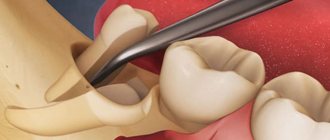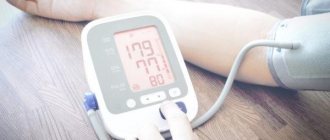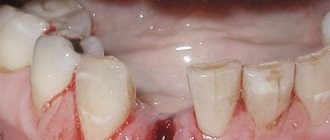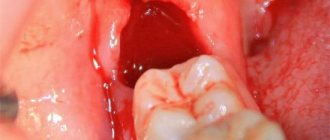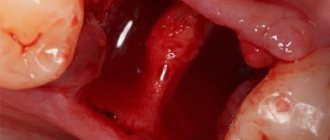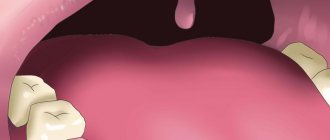Causes of pain
The further a tooth is in the row, the more difficult it will be to remove, as it has a more extensive root system. This often leads to inflammation and improper healing of the hole. According to statistics, complications are most often diagnosed after the removal of wisdom teeth (eight teeth). Also, the cause of long-term toothache is the lack of experience of the dental surgeon and incorrect removal tactics.
Let's look at the main complications that lead to long-term pain after tooth extraction:
- Bleeding – Bleeding normally stops within 30 minutes of surgery. But in people with diseases of the hematopoietic system, diabetes mellitus, the hole may bleed for several hours. The critical period is the first day. If you experience even slight bleeding during this time, consult your doctor. He will perform additional tamponade, diathermocoagulation or suturing of blood vessels.
- Alveolitis is a common infectious complication that is characterized by inflammation of the soft tissue around the socket. There are aching pains that intensify while eating. As the disease progresses, pain may radiate to the temple and ear on the affected side. Treatment by a dentist is required. Untimely treatment can lead to the development of an abscess and blood poisoning.
- Paresthesia is a loss of sensation that occurs when the mandibular or maxillary nerve is injured. Normally, the numbness goes away within 1 or 2 weeks. To reduce the period, physiotherapeutic methods are used. If discomfort persists for more than a month, you need to contact the dentist.
- Leaving tooth fragments in the wound - foreign objects in the socket interfere with the normal healing process, which leads to prolonged pain and inflammation. Small fragments may come out on their own when rinsing. X-ray diagnostics are required.
- An abscess is a purulent process that occurs in a hole as a result of infection. Accompanied by throbbing pain, fever, headache, and weakness. An opening and drainage of the abscess and antibacterial therapy are required.
- Osteomyelitis is an inflammation of the bone tissue of the jaw. Accompanied by acute pain, unpleasant odor, mobility of adjacent teeth, and swelling of the jaw. Pathological changes in bone tissue are visible on x-rays. In advanced cases, surgical treatment is required. Without treatment, the infection can spread to the soft tissues of the face and neck.
The most common cause of long-term pain after tooth extraction is the absence of a blood clot, that is, a “dry socket.” This pathology is often observed in older people, smokers and in patients with hormonal disorders.
Dangerous complications of long-term pain
Ignoring pain and tissue swelling can lead to serious complications that may require surgery.
When the inflammatory process is advanced, purulent foci form in the tissues, increasing the risk of pus spreading through the bloodstream throughout the body. The development of phlegmon and destruction of the jawbone is likely. With a hematoma, a thickening of the clot may occur, which will inevitably lead to the need for surgical intervention, the appearance of scars and an increase in recovery time.
How to relieve pain at home
For the first 2–3 days, pain and discomfort are a normal reaction of the body to injury. When removing sevens or eights (wisdom teeth), pain can be felt for up to 5 days. In addition, it can cover the entire jaw and radiate into the ear. This is normal if the pain decreases over time.
To speed up the gum restoration process, it is recommended:
- Do not apply heat to the painful jaw area. It is better to apply a cold compress, which will relieve inflammation and stop bleeding.
- Try not to eat on the injured side; food and drink should be at a comfortable, warm temperature.
- Rinse your mouth after every meal. It is better to use herbal decoctions with an antiseptic effect. It is also advisable to use pharmaceutical antimicrobial agents for rinsing.
- Until the hole has healed, do not use aggressive mouth rinses and toothpastes.
- Do not remove the blood clot or touch the socket.
If the pain is severe, you can take analgesics or non-steroidal anti-inflammatory drugs. They will not only reduce pain, but also relieve swelling.
Time frame for complete healing after tooth extraction
It is important to understand that tooth extraction is a full-fledged dental operation, after which a period of rehabilitation is required. During this time, the hole heals, pain decreases and the injured area of the gum is restored. There are several main stages:
- The first week after surgery is the period during which the hole is completely filled with granulation tissue. In the first days, a blood clot forms, and on days 4–5, normal granulation forms on top of it. Soreness, swelling, and redness begin to decrease normally within 3–4 days.
- Second week – the recovery process continues. On the 8th day, headaches and toothaches completely disappear, the local temperature of the gums normalizes, and the tooth socket heals. On days 10–14, the process of bone tissue restoration begins.
- The next 1–2 months are the period when intensive growth of bone tissue occurs. It completely fills the hole. However, the bone will become sufficiently strong no earlier than 5–6 months after tooth extraction.
The duration of rehabilitation depends on many features. So, molars have larger roots, which may have an irregular structure, so when they are removed, a large hole remains. Recovery can be lengthy even after removal of incisors or fangs if a cyst or abscess is discovered. It is important to monitor your well-being, but headaches in the first week after surgery are considered a normal reaction of the body.
When a doctor's help is needed
If you have the following symptoms, you should contact your dentist:
- if bleeding from the socket does not stop within 24 hours after tooth extraction;
- increased body temperature, weakness, headache;
- swollen lymph nodes;
- heavy bleeding, in which the patient has to change the cotton swab every 10-15 minutes;
- redness and swelling of the soft tissues near the hole, which are accompanied by acute, ongoing pain;
- severe numbness of the jaw;
- mobility of adjacent teeth;
- the appearance of bad breath;
- purulent discharge from the socket;
- formation of an abscess on the gum;
- liquid nasal discharge can occur when the maxillary sinus is injured as a result of difficult removal.
All these conditions require qualified medical care.
Headaches after using anesthesia
Very often, dentists use local anesthesia when treating teeth. After undergoing anesthesia, many patients experience headaches. There are several reasons for this type of pain:
- Presence of intolerance to anesthesia or incorrect choice of medication;
- Location of the diseased tooth in remote places;
Most often, the headache is aching in nature and tends to increase when moving the head.
If headaches began after the extraction of a diseased tooth, it is necessary to find the cause of the pain; it may be a complication of the operation.
Treatment methods
The treatment regimen depends on the cause of the pain, symptoms and severity of complications. After examination, X-ray diagnostics are used to clarify the diagnosis. It allows you to assess the condition of bone tissue and identify the presence of tooth fragments or root remains in the wound.
- Local treatment
Includes tight tamponade, use of a hemostatic sponge for heavy or prolonged bleeding. To relieve inflammation in the absence of complications, the doctor prescribes rinsing with antiseptics and using ointments with an analgesic effect. Aerosols with antimicrobial properties are effective for stomatitis.
- Drug therapy
Includes taking antibiotics for severe extractions, as well as for wisdom teeth removal. In case of loss of sensitivity (paresthesia), vitamin B complexes in capsules or injections are prescribed.
- Physiotherapeutic methods
UHF courses, electrophoresis, and microcurrent therapy help to cope with pain. On average, 10 sessions are recommended. This treatment is prescribed after the hole has healed.
- Surgery
If purulent contents are present, the abscess (abscess) is opened and cleansed. Turunda with a medicinal composition is placed in the wound. In case of a hematoma (accumulation of fluid or blood), an incision is made in the gum under local anesthesia and a drainage is installed. It helps drain the contents of the hematoma. After cleaning the wound, the doctor applies stitches.
You should not let the pathological condition progress and delay it until further surgery. A timely visit to the dental office will allow you to use gentle medicinal treatment methods.
What to do if alveolitis begins?
As mentioned above, alveolitis is an inflammation of the tooth socket. Here, in addition to normal tissue swelling, you will also experience redness of the mucous membrane, acute pain, and an odor from the socket (as pus and food debris accumulate there). These symptoms are increasing every day.
Alveolitis cannot be treated at home. By taking antibiotics, ointments, rinses and other “home” measures, you can either achieve nothing at all, or transfer the process into a chronic form, when, with minimal symptoms, the bone in the area of removal will dissolve and as a result we will get a huge defect in the bone, which will be difficult to correct. Alveolitis in Samara should be treated only together with a surgeon, strictly adhering to his recommendations.
What does a surgeon do for alveolitis?
- Anesthesia is given;
- When everything has become numb, the surgeon cleans the tooth socket again (removes pus, tooth fragments or bones, if any, rinses the socket with solutions of antiseptics and antibiotics);
- After treating the wound, there are two options: some kind of drug can be put into the hole. Or they can simply fill it with fresh, clean blood and wait for a new clot to form;
- After cleaning, antibiotics, rinses, and epithelializing drugs are prescribed.
After such measures, a noticeable improvement occurs on the second or third day (pain and swelling begin to subside), but healing of the hole takes longer - up to three weeks.
Prevention of complications
Tooth extraction is a radical measure when other treatment methods have proven ineffective. To avoid long subsequent recovery, you must follow your doctor's recommendations.
In the first hours after the procedure, do not smoke or eat. These are important rules that many people ignore, which leads to infection in the socket.
On the day of tooth extraction, do not actively rinse your mouth.
This may damage or flush out the blood clot that helps the socket heal. Do not drink alcohol until the wound is completely healed. Alcohol increases bleeding. Avoid strenuous physical activity, and visiting public places such as swimming pools and lakes is also prohibited. It is impossible to warm up the injured jaw area, so in the first week do not visit the sauna, bathhouse or take a hot bath.
Ways to eliminate the pain reaction
All medications are prescribed individually. The doctor selects treatment methods only after examining and establishing the cause of the problem. However, some aspects of pain management are suitable for everyone.
They are as follows:
- Immediately after surgery, it is recommended to apply a cold compress to the cheek. If ice is used, it should be applied through a thin cloth. It is necessary to observe the time regime and not to overcool the well.
- Start rinsing on the second or third day after surgery. The best antiseptic solution is regular baking soda and salt. To prepare it, take half a teaspoon of these components and thoroughly dissolve it in boiled water at room temperature. Rinse 3-4 times a day, especially after meals.
- If there is an inflammatory process, the doctor must start antibacterial drugs. Amoxiclav, Sumamed, Biseptol have a good effect. These medications are taken even after all symptoms have subsided. It is important to follow the course prescribed by the doctor.
- At home, if throbbing pain occurs, antiseptic irrigation and oral baths are indicated. The most commonly used are Chlorhexidine, Miramistin, Rivanol, Rotocan, Stomatofit, Iodinol. The price of the drugs is insignificant, but their high effectiveness has been proven in practice many times.
- If the unpleasant sensation increases, painkillers such as Analgin, Diclofenac, Ketanov are indicated. You should not use antispasmodic drugs, as they have a completely different effect and are not able to help in this situation.
Antiseptic solutions for rinsing the mouth for inflammation of the socket
To prevent the development of a pain reaction, it is necessary to adhere to the following recommendations:
- after tamponade of the hole, the gauze pad must be kept in the oral cavity for half an hour;
- do not eat for 3-4 hours;
- it is necessary to keep the blood clot in the socket and protect it in every possible way for about a day after extraction;
- It is forbidden to apply dry heat to the cheek, take a bath, visit a sauna, or use hot antiseptic solutions;
- for three days you should not eat spicy, too sour, salty or hard foods;
- avoid hypothermia of the wound if removal occurred in winter;
- You should not use alternative medicine to relieve pain, as they can lead to purulent complications;
- hot drinks and alcohol are prohibited;
- Avoid contact of the wound surface with household items.
It is important to follow all dentist recommendations for oral care. After the tooth is removed from the alveolar process, traditional cleaning can be carried out two days later.
If the pain reaction increases, you should not take painkillers endlessly. It is better to contact your dentist for help as soon as possible, and do not use any medications, including analgesics, during the next few hours of your visit. During this period, only the application of cold to the area where the operation is performed is allowed.
Sometimes it happens that after surgery the gums pulsate and the tooth that is located next to the removed one hurts. The reason for this manifestation could be injury to the pulp tissue in the “neighboring” tooth, if its roots were located very close to the roots of the exposed unit.
As a result, the vascular-nerve bundle of fibers that enter through the apical foramen in the area of the root apexes and nourish the pulp tissue is damaged. In this case, the tooth will have to be opened and treated according to the type of acute pulpitis.
Relieving pain with folk remedies
If you experience headaches after a recent visit to the dentist, you must first identify the cause of the disease. It is impossible to do this on your own without visiting a doctor. You can use some traditional medicines, but you should consult your doctor before using them.
- Drinking mint tea is good for eliminating cramps and reducing headaches;
- Freshly prepared viburnum juice - drink one hundred grams for headaches twice a day for five days;
- The use of hot foot baths is a proven folk method for relieving headaches;
You should know that the occurrence of headaches after dental treatment may be one of the first prerequisites for the occurrence of more dangerous diseases.
Painful sensations mean that inflammatory processes are occurring in the body, so you need to consult a specialist; you should not self-medicate. Moscow metro station Zvezdnaya, Danube Avenue, 23
